|
|
|
|
#1 |
|
Banned
Join Date: Feb 2005
Location: Somewhere between lost & found traveling @ a high rate of speed.
Posts: 1,256
|
From the photographs and drawings of Stephen Selby.
By Bede Dwyer Introduction. This is written to give a historical context to the information that Stephen Selby brought back from the museum in Urumqi on some ancient bows. They have not been widely published in Chinese or English, but they are very significant for the study of archery history. Stephen supplied me with the descriptions, but my imagination supplied the reconstructions. I also redrew his sketches so any errors are mine. The Location Shanshan County, to the east of Urumqi, is on the Northern Route of the Silk Road, which splits in two to pass the extremely arid Takla Makan Desert. To the East is the Gobi Desert; to the west is the Tarim Basin, which drains the mountains to the north. Its watercourses eventually evaporate in the Takla Makan. Subeshi (Subeixi) is situated to the east of the famous Silk Road town of Turpan (Turfan). Since early exploitation by foreign archaeologists in the nineteenth and early twentieth century, the area has continued to reveal amazing relicts of the past. Modern Chinese archaeologists have revealed more details of the ancient inhabitants and their ways of life. The unique dry conditions have preserved usually perishable artifacts and even the bodies of some of the people buried there. What have surprised many in the West were the European features of some of the bodies. However, ancient Chinese historians had recorded the variety of races on their northwestern border as far back as the Han Dynasty. This area was both a trade route and the point of contact many people from different environments and cultures. People farmed and traded in the oases and nomads visited both for trade and warfare. The Artifacts Stephen Selby examined several bows in Urumqi that were of various designs and from several periods. One type of great significance to the history of archery was very similar to bows familiar in the West from Greek, Persian and Scythian [i] art. I will discuss why this is not so surprising below, but firstly I will describe one of the bows. The bow in question possessed a feature that is no longer common in modern composite bows. It was thick and narrow in the cross-section of that part of the limb where it bends. Unlike later bows, with their broad lenticular or rectangular bending sections, this bow had a triangular section with the apex on the belly side of the limb. The back of the bow was slightly convex and formed the base of the triangle. At the centre of the bow, the limbs are 4 cm wide. For a greater part of the limb it had this unusual shape. 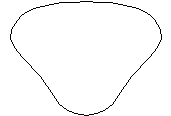 Figure 1 Cross-section of centre area of bow.  Figure 2 Cross-section of recurve. In outline, the bow looks like the Classical Cupid’s bow of Greek and Roman art. This is not an accident. Despite being found in the modern confines of China, this bow represents a survival of the ancient Scythian bow, which was used from Italy in the west to the north of China in the east. Roman armies might have carried them even further west. Remains of later Roman archery equipment have been found in Britain, both grip scales and laths for the ears. However, the Scythian bow would leave no telltale laths in the archaeological records. Even in the heartland of the Scythians, modern Russia and the Ukraine, very few identifiable remains of bows remain. 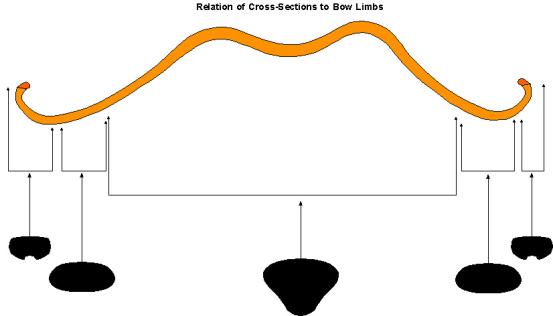 Figure 3 Subeshi Bow and Sections (Not to scale) 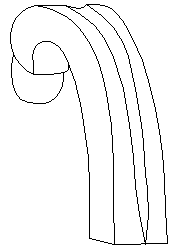 Figure 4 Simplified drawing of bow tip from belly side showing string groove 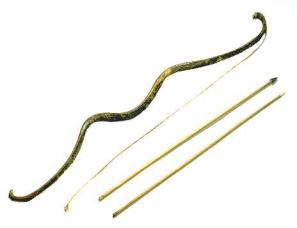 Figure 5 A Scythian style bow from Subeshi in Shanshan County, Xinjiang 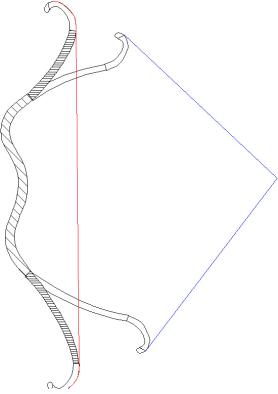 Figure 6 A sketch of how a bow may have appeared strung and drawn  Figure 7 A Western Scythian style bow reconstruction by David Betteridge
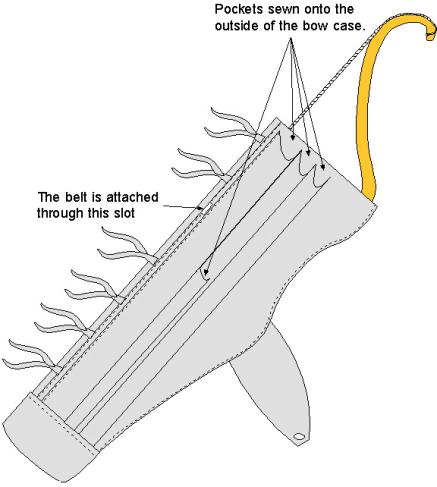 Figure 8 Drawing of a gorytos of the Eastern type The leather tab on the bow case part of the Urumqi Museum gorytos may represent another way the gorytos could be worn. If a strap ran from the upper edge suspension point of the gorytos to the hole in the tab, the strap could be slung over the left shoulder. This should make the gorytos hang diagonally across the back and position the openings of both bow case and quiver next to the right shoulder. This is pure speculation. The Origin of the Scythians. Warlike horse nomads are first mentioned in the West in Assyrian documents in the eighth century BCE. These Cimmerians were eventually over thrown by the tribes the Greeks called Scythians. They raided extensively in the Near East and eventually allied with the Medes of western Iran to destroy the Assyrian kingdom. According to the ancient historian, Herodotus [ix], the Medes then murdered the Scythian leaders at a banquet and drove their forces out of the Middle East. The Scythians retreated to the Pontic steppe through the Caucasus. Reading the account of Herodotus, you might be excused for imagining that the Scythians were a group of longhaired, bearded barbarians of a violent and emotional nature, who drank the blood of their enemies and were addicted to cannabis-laced sweat baths. However, there is much more to them than that. The first nomads of the steppe north of the Black Sea mentioned in the ancient historians were the Cimmerians who seem to have originated in that area. They were early nomadic pastoralists who adopted a stock raising, wandering lifestyle as an alternative to mixed farming. The Scythians appeared from the east and started driving the Cimmerians before them. The Cimmerians raided south through the passes of the Caucasus and ravaged Anatolia. Some scholars believe that the Scythians originated in southern Kazakhstan [x]. Therefore Scythian-style culture could have radiated east and west from a common centre. The Scythians were predominantly horse archers. Because of the vast area they dominated, archaeological evidence for them is geographically dispersed. So much so, that it would be difficult to prove racial or linguistic uniformity, even though we can see lifestyle and artistic continuities between these sites. At one end of the geographical range, gold vessels provide illustrations of the horse gear and equipment used, while at the other end frozen tombs provide actual saddles, bridles and the corpses of horses. Herodotus wrote about their daily life and, until the discoveries at Pazyryk in the Altai Mountains, he was generally believed to be unreliable about the Scythians. However, many strange details of his narrative have proved to be true, such as hemp-enriched steam baths and the habit of scalping their enemies. The Scythians and people in Scythian dress were widely depicted in Ancient Greek art. The Achaemenid Persians [xi] included eastern Scythians (the Sakas) among the tribute bearers in the bas-reliefs at Persepolis [xii]. The bows discovered in Xinjiang are as important to the study of archery as the frozen tombs in Pazyryk were to the general studies of the Scythians. Until these discoveries were made, only fragments of Scythian bows and representations could be studied. Of archery equipment, only metal fittings for the gorytos, a combined bow case and quiver, arrowheads and a few parts of arrows survived. (I have not included any illustrations of the typical Scythian three-bladed, bronze arrow heads here because I do not know if any have been found in association with these bows.) The typical Scythian warrior was a horseman who used archery as his prime offensive weapon. On his left side he wore a gorytos. The arrows were typically tipped with two or three-sided bronze arrowheads. At the western end of the steppe the arrows that survived were usually between 55 and 60 cm long [xiii]. At Pazyryk, however, broken arrows were reassembled to suggest a length of 80 cm. From western steppe tombs, large gold plates were excavated which were evidently the covers of the outside faces for the wood and leather gorytoi. In art, the gorytos was usually two-thirds to three-quarters the strung length of the bow. The gorytos plates for which I have measurements are about 45 cm long. The whole gorytos was probably about 55 to 60 cm long, making it about the length of the arrows found in the same area. 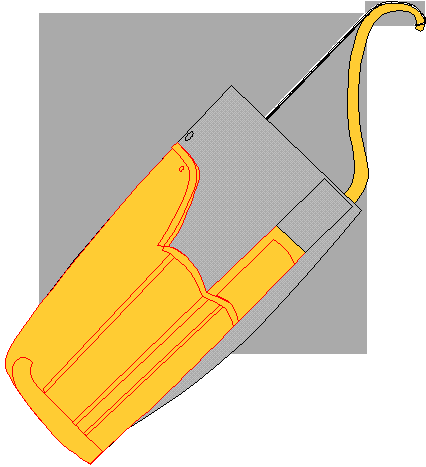 Figure 9 Simplified view of a Western Scythian Gorytos. These saddles are depicted in Scythian gold and silver work from Russia and the Ukraine, in Siberian gold buckles, and on the pottery horses of Qin Shihuangdi’s cavalry. Real examples were found frozen in the tombs of Pazyryk [xiv] and a dried-out saddle [xv] near the burials of our bows and gorytoi. The Medes and some Persians are shown in the Persepolis reliefs wearing gorytoi that are longer than those of Saka tribesmen in the same group of reliefs. In both cases, there is a cover over the projecting part of the bow, so details of its shape other than its profile are impossible to see. The exception is that there is some detail of the recurvature of the bow because the bow was strung and carried belly-up. The soft cover of the bow shows a rounded profile. In the same group of reliefs other Persian soldiers are shown using a longer bow without a setback handle. They carry a large shoulder quiver instead of the gorytos. In the collection of the Urumqi museum there are bows, arrows and gorytoi of the longer eastern type, but obviously related to the western Scythian equipment. Some features of the gorytos are similar to one depicted in an architectural decoration in the old Parthian capital of Nysa in Central Asia. Of particular interest is the use of multiple pockets for the arrows on the outside face of the gorytos. Some of the gold gorytos plates from Russia have surviving bases in the form of an elongated teardrop with the narrow end facing upwards. There is usually a ridge down the centre of the base showing the separation of the bow case and quiver sides of the gorytos. The gorytos in the Urumqi museum [xvi] has only a supporting wooden rod rather than the two- or three-sided wooden frame implied by the shapes of gorytoi in Greek and Scythian art and the gold plates with their bases. The Nysa gorytos looks more like the Urumqi example because it has a rounded base rather than the flat one of the Western types. This is also true of the gorytoi on the Persepolis bas-reliefs. The Scythian Bow. There is a complex of weapons associated with the Scythian lifestyle. They include the bow, arrows and gorytos. In the West the arrows almost always had socketed, three-bladed heads and were made of bronze [xvii]. There is also a short sword called by the Greeks, an akinakes, which was worn on the right side with the chape of the scabbard sometimes tied down to the right thigh. Another common weapon is a narrow-bladed battle-axe with some resemblance to the Chinese dagger-axe (ge) and ancient Near Eastern weapons. Spears and javelins are also common in tombs. Increasingly discoveries in Eastern Europe are adding weapons and armour to this catalogue. The use of scale armour is much more prominent than once thought and long two-edged swords are also more frequent. We can list a number of features that can used to characterize a Scythian bow.
The recurved tips are a new development in archery at the time, though you can see that they had ancestors. The Assyrians and Elamites used triangular composite bows with bird’s head shaped nocks for the strings. Since the string loop had to attach to the bird’s beak on the back of the bow some form of basic groove was probably carved in the tip of the bow to lead the string over. Prior to that narrowing the tip of the bow abruptly to make two shoulders formed the string nock. On some Ancient Egyptian bows this was carried to the extreme of having the nocks of the bows carved into representations of Pharaoh’s enemies, their shoulders the shoulders of the nock, their head the peg-like nock itself. Every time the king drew his bow he strangled two of his enemies in effigy [xviii]. 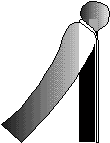 Figure 10 View of an Ancient Egyptian bow tip 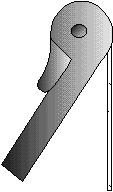 Figure 11 View of a late Assyrian bow tip.  Figure 12 View of the tip of a bow from the Achaemenid palace at Susa. 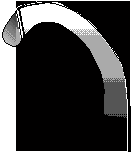 Figure 13 View of the tip of the bow from the Urumqi Museum 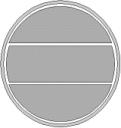 Figure 14 Cross-section based on parts of a Scythian bow from the Three Brothers Kurgan and fragments from Sivush. The Egyptians had separate bow cases for their bows mounted on their chariots, but the Assyrians just stuffed them into their quivers. In both areas, the quiver was worn on the back when it was not attached directly to the chariot. At some stage, someone decided that a bow case attached to a quiver would be a good idea. With the small Scythian bow and arrows, the resulting object was not too unwieldy. The advantages were obvious: the bow was protected from the weather and the points of the arrows. The case also prevented the bow from being distorted, yet it was ready to hand already strung. Drawing short arrows across the body was no great trouble (the Plains Indians in America, when they reinvented mounted archery did a similar thing). However, that brings us back to the Urumqi bows. Their arrows were not short and there is some evidence that even in the West these larger Scythian bows were in use [xxii]. The Urumqi gorytoi [xxiii] are almost a metre long (90 cm) and the arrows are about 80 cm long. So too were the arrows from Pazyryk. The Siberian gold belt plaques show people drawing to the ear. Perhaps they were nearing the outer edge of utility for a gorytos. Coupled with this large size, these gorytoi do not seem to hold as many arrows as the smaller Western ones. This could mean that the archers needed fewer because their larger arrows were more effective. It could also mean these were hunting quivers and they did not have to carry many arrows. The arrows had a mixture of wooden, horn and metal tips. The Scythians at War. The Scythians were primarily cavalry fighters. They rode into battle and fought on horseback. Herodotus describes their tactics when fighting the Persian army led by Darius the Great. They used traditional scorched earth tactics and retreated before the large Persian army, successive leading the Persians through each of their subject states so that their own lands were not ravaged. After various taunts directed at the Persians, they informed Darius that they would stand and fight if the tombs of their ancestors were desecrated. This was the last straw for the Great King [xxiv], who turned around and went home. Scythian horse archers had consistently prevented the Persian army from foraging and had left Darius little choice. This was a tale of frustration from the Persian point of view. The Scythians effectively contained the largest army of the Middle East and actually used it to do their own dirty work by punishing their less enthusiastic allies. Lest we underestimate the Persians, remember that they transported this large army from Persia through Anatolia, across the Bosphorus on a bridge of boats, through Thrace and onto the steppe lands of Eurasia. The logistical skills, with which they consistently underpinned their great military expeditions, are really remarkable. However, they were outmanoeuvred by the Scythians and confined by their swarms of horse archers. Against a smaller army, the Scythians could be much more aggressive and use their weapons more directly. In later years, they were a thorn in the side for Macedonia and it took Alexander the Great to defeat their king, Ateas. This combination of effective archery and speed of manoeuvre led to an arms race on the steppe. Armour became popular and the Scythians themselves eventually became victims of their more heavily armoured relatives, the Sarmatians [xxv]. These bows are significant for two separate reasons. They provide use with examples of how an early type of bow looked and will eventually help us learn how it was constructed. They also show us how widespread the Scythian steppe culture was and how the Chinese were able to absorb some of its technical innovation. If I have spent so much time on the Scythians, it is because this archery evidence of their presence so far east is remarkable and it shows that the great civilisations of the world were not as isolated from each other as we often think. Some Questions. There are several questions raised by these bows and their associated equipment. ·How were they shot? What technique was used to draw the bow? ·How were they constructed? What materials were used? ·How effective were they? How did they perform? ·Who made them and did they influence other bows? ·What is the relationship between the people who were buried with these bows and the various groups living a “Scythian” lifestyle? |
|
|
#2 | |
|
Senior Member
Join Date: Jan 2006
Posts: 4,473
|
Some historians have suggested that the "Om" sign is a Sanskrit/Vedic symbol originating with the White Scythian bow.
http://www.stormfront.org/forum/show...light=sanskrit Quote:
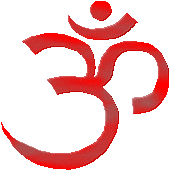  
|
|
|
|
#3 | |
|
Banned
Join Date: Feb 2005
Location: Somewhere between lost & found traveling @ a high rate of speed.
Posts: 1,256
|
One of these designs would make a nice slut stamp for Moronicoon or Pixi.
Quote:
|
|
|
|
#4 |
|
Banned
Join Date: Sep 2006
Posts: 371
|
Well, what fascinates me the most about ancient Scythian culture, is how it relates to race mixing today. For example, according to archeologists, Scythian culture spread all the way eastwards towards modern day China and Mongolia. Meaning, that Scythian whites no doubt came into contact with ancient racial mongols. That, in my opinion, is the crux of our whole racial problem. After all, this contact between two vastly different races occured before International Judiasm hit the center stage in our times. What happened? Was there some form of race war that occured? Did the two White Caucasion and mongol races mix over time forming the "Turkish" racial embryo we see today?
|
|
|
#5 | |
|
Banned
Join Date: Feb 2005
Location: Somewhere between lost & found traveling @ a high rate of speed.
Posts: 1,256
|
The Scythians were the first to domesticate the horse, the mongol race did not obtain the horse until the 5th-4th century B.C. the Scythians using the Altai mountains as a springboard made raids deep into Mongolia in the 7th-6th century B.C. their mixture with the Xiong-nu created the Huns & Turks. It is a known fact that the Huns & Turks were of mixed race, it is said that Genghis Khan had green eyes. Perhaps he looked somewhat like this Mongol girl:
 This nine-year-old Mongolian girl, Meiramgul, is blond and may share genetic traits with the ancient Sarmations. The Mongol Army Commander of Haluga Khan, Kitibuq Noyen traces his ancestry to the same Arsacid family, that my family is descended from, yet I have very blond hair and blue eyes, although my blood type and haplo group is consistent with the Ossetians of today and the ancient Sarmatians and Alans. Ammianus Marcellinus said this of the Alans "Almost all of the Alans are tall and good looking; their hair is generally blond, and their eyes are frighteningly fierce" Actually Scythian culture spead all the way to Japan, the art of yabusame was taught to them by the Alans. Marco Polo recorded seeing an Army of over 10,000 Alan cataphracts in service to the Chinese emperor during his travels there. The Alans also settle in Portugal. The Alans merged with the Vandals and invaded Spain and then North Africa from there a group of them sailed to Valentia in Ireland. These people were highly mobile even in ancient times. Quote:
|
|
 |
| Share |
«
Previous Thread
|
Next Thread
»
| Thread | |
| Display Modes | |
|
|
All times are GMT -5. The time now is 02:25 AM.
Page generated in 1.09875 seconds.




 Linear Mode
Linear Mode
